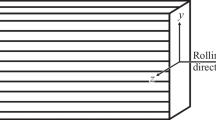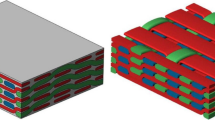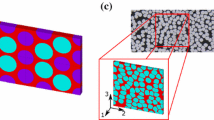Conclusions
-
1.
The approximate structural model for calculating the stressed state of 4D composites and the tensor-polynomial criterion, accounting for the anisotropy and matrix of unlike strengths upon tension-compression of a material permits us to elucidate the change in the ultimate stresses of the composite relative to the reinforcement angles and load application direction.
-
2.
Variation of the fiber packing directions in two orthogonal planes was used to show that isotropy in the composite strength determined by the ultimate stresses upon failure of its weakest link cannot be achieved. The least deviation from such isotropy is obtained at the spatial reinforcement angle θ = 54.7 °. For this angle, we find a very low percentage of the ultimate tensile stress (about 7%), while there is a significant enhancement of the ultimate shear stress (to 220% in comparison with the corresponding indices of the unidirectional material along the fiber packing direction).
-
3.
In the case of symmetrical spatial arrangement of straight fibers at an angle θ = π/4 to the direction of the tensile force, the value of δx * is twice that for planar fiber packing (±ϕ) when ϕ = θ. There is no significant difference in the θx * values for these structures in the case of low reinforcement angles. When θ > 65 °, the values of the ultimate stress θx * are constant and minimal when evaluated according to the polynomial criterion, though they are twice as large when evaluated according to the criterion for greatest deformation transverse to the fibers.
-
4.
The ultimate shear stress between the two planes of a spatially reinforced composite with arbitrary fiber directions parallel to these planes is independent of the reinforcement angles and close in magnitude to the shear strength along the fibers of a unidirectional composite with identical properties of the fiber and matrix and same reinforcement coefficient.
Similar content being viewed by others
References
N. A. Alfutov, P. A. Zinov'ev, and B. G. Popov, Calculation of Multilaminar Composite Plates and Shells [in Russian], Mashinostroenie, Moscow (1984).
Guang Wu and Frank Ko, “Analysis and design of 2D braided preforms for composite reinforcement,” Proc. ICCM/9 (Madrid, 1993). Composite Design (1993), pp. 532–539.
N. S. Bakhvalov and G. P. Panasenko, “Determination of the processes in periodical media,” in: Mathematical Problems in Composite Mechanics [in Russian], Nauka, Moscow (1984).
J.-M. Yang, C.-L. Va, and T. W. Chou, “Fiber inclination model of three-dimensional textile structural composites,” J. Composite Materials,20, 472–484 (1986).
A. F. Kregers and G. A. Teters, “Structural model for the deformation of anisotropic spatially reinforced composites,” Mekhan. Kompozitn. Mater., No. 1, 14–22 (1982).
T. D. Shermergor, Theory of the Elasticity of Macrononuniform Media [in Russian], Nauka, Moscow (1977).
J. D. Eshelby, “The determination of the elastic field of an ellipsoidal inclusion and related problems,” Proc. Roy. Soc. Ser. A, 241, 376–396 (1993).
V. A. Polyakov and I. G. Zhigun, “Evaluation of ultimate tensile and shear stresses of 4D composites reinforced along the diagonals of a cube. 2. Analysis of ultimate loads,” Mekhan. Kompozitn. Mater., No. 6, 772–784 (1993).
G. A. Abu-Farsakh, “New material models for nonlinear stress-strain behavior of composite materials,” Composites,20, No. 4, 349–360 (1989).
I. I. Gol'denblat and V. A. Kopnov, Strength and Elasticity Criteria for Structural Materials [in Russian], Mashinostroenie, Moscow (1968).
A. F. Zilauts and A. F. Kregers, “Deformation surfaces of a composite material,” Mekhan. Polim., No. 6, 975–981 (1976).
Author information
Authors and Affiliations
Additional information
Translated from Mekhanika Kompozitnykh Materialov, Vol. 30, No. 5, pp. 626–645, September–October, 1994.
Rights and permissions
About this article
Cite this article
Polyakov, V.A., Zhigun, I.G., Shlitsa, R.P. et al. Structural model analysis of ultimate stresses in spatially reinforced 4D composites. Mech Compos Mater 30, 455–468 (1995). https://doi.org/10.1007/BF00616774
Received:
Issue Date:
DOI: https://doi.org/10.1007/BF00616774




